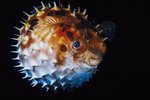Leeches are parasites that feed on the blood of fish, frogs, turtles and mammals. Leeches are freshwater carnivores found in lakes and ponds. Humans are scared of leeches because of their unattractive appearance and the fact that leeches can feed on human blood. Leeches are worms that detect their prey through vibrations and swim very fast to attach to their hosts and feed. Leeches can attach themselves to prey using their mouth and tail.
Mouth
Leeches do all of their actual feeding through their mouth. They use their jaws to hold onto the host. The leech has sharp teeth in its mouth sucker, and it uses the teeth to sink in and attach to its prey to feed. The leech releases an anticoagulant called hirudin to stop the host’s blood from clotting. Leeches feed until full, then they unhook their jaws and drop off the host.
Tail
Leeches can also attach to hosts using the sucker on their tails, or the posterior sucker. The posterior sucker helps the leech move quickly through the water and also helps the leech climb the host's leg. The leech finds a protected spot on the host, then attaches the jaws from the mouth to begin feeding. The leech does not actually suck the host's blood with the posterior sucker.
Feeding Facts
Leeches release an anesthetic into the host's blood to prevent the host from becoming aware that the leech is sucking its blood. Leeches digest blood slowly. They can live on the blood consumed at one feeding for several months. As they consume blood, their body can grow up to five times its normal size, because they can consume several times their own weight in blood.
Other Food
Blood is not the only food that leeches eat. They eat small animals in ponds, frogs, tadpoles, worms and snails. The food of choice will depend on the type of leech. They use their body's receptor to detect their prey's presence and movements. They can also sense carbon dioxide, so they know when a breathing host is near.
References
Photo Credits
-
Michael Blann/Digital Vision/Getty Images
Writer Bio
Sarah L. Harrer has more than eight years of experience as an editor at Thomson Reuters. She has edited titles such as "Lindey on Entertainment, Publishing and the Arts," and written several continuing education manuals. Harrer's work has also been published in "The Pioneer" and "The Angle." She holds a Bachelor of Arts in English from St. John Fisher College.





